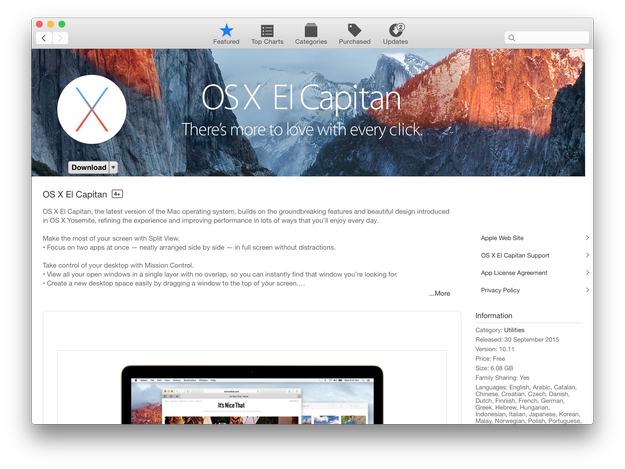Bootable USB Installers for OS X Mavericks to Sierra
Virtualising OS X 10.11 El Capitan The ability to virtualise OS X 10.11 El Capitan is important and very useful as it is an easy way to run 32-bit applications that do not run on m Return to site MacStrategy presents this special guide to virtualising Mac OS X / OS X / macOS. Apr 27, 2021 Download: OS X El Capitan This downloads as a disk image named InstallMacOSX.dmg. On a Mac that is compatible with El Capitan, open the disk image and run the installer within, named InstallMacOSX.pkg. It installs an app named Install OS X El Capitan into your Applications folder. OS X El Capitan.app 10.11.6. Due to a planned power outage, our services will be reduced today (June 15) starting at 8:30am PDT until the work is complete. Sep 30, 2015 Download OS X El Capitan. All Mac users who wish to download OS X El Capitan must do so from the Mac App Store, where it is available as a free download from Apple: Get the final version of OS X El Capitan from the App store here; The El Capitan installer is about 6GB in size. Edit 2016: This is true for any OS except El Capitan - Apple are leaving it available so devices ineligible for Sierra can still obtain it. You need to already have it in your Purchase History, otherwise once it's gone from the App Store, that's it, it's gone.
First, review this introductory article: Create a bootable installer for OS X Mavericks or Yosemite - Apple Support. Second, see this How To outline for creating a bootable El Capitan installer. Simply replace the Terminal command with the one from the preceding article by copying it into the Terminal window.
You will need an 8GB or larger USB flash drive that has been partitioned and formatted for use with OS X.
Drive Partition and Format
- Open Disk Utility in the Utilities folder.
- After Disk Utility loads select the drive (out-dented entry with the mfgr.'s ID and size) from the side list.
- Click on the Erase tab in the Disk Utility toolbar. Name the drive, 'MyVolume'. <---- IMPORTANT!
- In the drop down panel set the partition scheme to GUID. Set the Format type to Mac OS Extended (Journaled.)
- Click on the Apply button and wait for the Done button to activate. When it does click on it.
- Quit Disk Utility.
Create Installer
Os X El Capitan Installer App
Open the Terminal in the Utilities folder. Choose the appropriate command line (in red) depending upon what OS X installer you want. Paste that entire command line from below at the Terminal's prompt:
Command for macOS Sierra:
sudo /Applications/Install macOS Sierra.app/Contents/Resources/createinstallmedia --volume /Volumes/MyV --applicationpath /Applications/Install macOS Sierra.app
Command for El Capitan:
sudo /Applications/Install OS X El Capitan.app/Contents/Resources/createinstallmedia --volume /Volumes/MyVolume --applicationpath /Applications/Install OS X El Capitan.app
Command for Yosemite:
sudo /Applications/Install OS X Yosemite.app/Contents/Resources/createinstallmedia --volume /Volumes/MyVolume --applicationpath /Applications/Install OS X Yosemite.app
Os X El Capitan Download App Store
Command for Mavericks:
sudo /Applications/Install OS X Mavericks.app/Contents/Resources/createinstallmedia --volume /Volumes/MyVolume --applicationpath /Applications/Install OS X Mavericks.app

Press RETURN. You will be asked for your admin password. It will not echo to the Terminal window. Then press RETURN again. Wait for the return of the Terminal prompt signifying the process has completed. It takes quite some time to finish. Be patient.
Oct 5, 2016 8:12 PM
Bootable USB Installers for OS X Mavericks to Sierra
First, review this introductory article: Create a bootable installer for OS X Mavericks or Yosemite - Apple Support. Second, see this How To outline for creating a bootable El Capitan installer. Simply replace the Terminal command with the one from the preceding article by copying it into the Terminal window.
You will need an 8GB or larger USB flash drive that has been partitioned and formatted for use with OS X.
Drive Partition and Format
- Open Disk Utility in the Utilities folder.
- After Disk Utility loads select the drive (out-dented entry with the mfgr.'s ID and size) from the side list.
- Click on the Erase tab in the Disk Utility toolbar. Name the drive, 'MyVolume'. <---- IMPORTANT!
- In the drop down panel set the partition scheme to GUID. Set the Format type to Mac OS Extended (Journaled.)
- Click on the Apply button and wait for the Done button to activate. When it does click on it.
- Quit Disk Utility.
Create Installer
Open the Terminal in the Utilities folder. Choose the appropriate command line (in red) depending upon what OS X installer you want. Paste that entire command line from below at the Terminal's prompt:
Os X El Capitan Installer App Free
Command for macOS Sierra:
Os X El Capitan Installer Application Download
sudo /Applications/Install macOS Sierra.app/Contents/Resources/createinstallmedia --volume /Volumes/MyV --applicationpath /Applications/Install macOS Sierra.app
Os X El Capitan Download App
Os X El Capitan Installer Application
Command for El Capitan:
sudo /Applications/Install OS X El Capitan.app/Contents/Resources/createinstallmedia --volume /Volumes/MyVolume --applicationpath /Applications/Install OS X El Capitan.app
Command for Yosemite:
sudo /Applications/Install OS X Yosemite.app/Contents/Resources/createinstallmedia --volume /Volumes/MyVolume --applicationpath /Applications/Install OS X Yosemite.app
Command for Mavericks:
sudo /Applications/Install OS X Mavericks.app/Contents/Resources/createinstallmedia --volume /Volumes/MyVolume --applicationpath /Applications/Install OS X Mavericks.app
Press RETURN. You will be asked for your admin password. It will not echo to the Terminal window. Then press RETURN again. Wait for the return of the Terminal prompt signifying the process has completed. It takes quite some time to finish. Be patient.
Oct 5, 2016 8:12 PM



